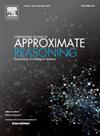On Fast arc-reversal
IF 3
3区 计算机科学
Q2 COMPUTER SCIENCE, ARTIFICIAL INTELLIGENCE
引用次数: 0
Abstract
Fast arc-reversal (FAR) was recently proposed as a new exact inference algorithm in discrete Bayesian networks (BNs), merging favourable features of Arc-reversal (AR) and Variable elimination (VE). AR constantly maintains a sub-BN structure when rendering a variable barren via arc reversals, often requiring more computational effort than VE, which sacrifices a sub-BN structure by directly eliminating a variable. It was formally established that FAR can recover a unique and sound sub-BN structure after consecutive variable eliminations. Experimental results on real-world benchmark networks empirically show an improvement in the average run-time and variance of FAR compared to AR. A novel method, called d-contraction, was suggested for graphically understanding FAR since FAR is not always the same as a sequence of arc reversals. Here, we extend this work by formally establishing that AR's sub-DAG is necessarily contained within FAR's sub-DAG. Unfortunately, neither FAR nor AR can guarantee the construction of minimal I-maps, although both methods may subsequently recover minimal I-mapness. Finally, it is shown how FAR improves Sum-Product network interpretability by relaxing a restriction on the elimination ordering used.
关于快速弧反转
快速弧反转(FAR)是近年来提出的一种新的精确推理算法,它融合了弧反转(AR)和变量消除(VE)的优点。当通过电弧反转使变量变为空时,AR不断保持子bn结构,通常需要比VE更多的计算工作量,后者通过直接消除变量牺牲子bn结构。正式确立了经过连续变量消去后,FAR可以恢复出独特而健全的子bn结构。现实世界基准网络的实验结果表明,与AR相比,FAR的平均运行时间和方差有所改善。由于FAR并不总是与一系列弧反转相同,因此建议使用一种称为d-收缩的新方法来图形化地理解FAR。在这里,我们通过正式建立AR的子dag必须包含在FAR的子dag中来扩展这项工作。不幸的是,FAR和AR都不能保证构造最小i -map,尽管这两种方法随后都可以恢复最小i -map。最后,展示了FAR如何通过放宽对所使用的消去顺序的限制来提高和积网络的可解释性。
本文章由计算机程序翻译,如有差异,请以英文原文为准。
求助全文
约1分钟内获得全文
求助全文
来源期刊

International Journal of Approximate Reasoning
工程技术-计算机:人工智能
CiteScore
6.90
自引率
12.80%
发文量
170
审稿时长
67 days
期刊介绍:
The International Journal of Approximate Reasoning is intended to serve as a forum for the treatment of imprecision and uncertainty in Artificial and Computational Intelligence, covering both the foundations of uncertainty theories, and the design of intelligent systems for scientific and engineering applications. It publishes high-quality research papers describing theoretical developments or innovative applications, as well as review articles on topics of general interest.
Relevant topics include, but are not limited to, probabilistic reasoning and Bayesian networks, imprecise probabilities, random sets, belief functions (Dempster-Shafer theory), possibility theory, fuzzy sets, rough sets, decision theory, non-additive measures and integrals, qualitative reasoning about uncertainty, comparative probability orderings, game-theoretic probability, default reasoning, nonstandard logics, argumentation systems, inconsistency tolerant reasoning, elicitation techniques, philosophical foundations and psychological models of uncertain reasoning.
Domains of application for uncertain reasoning systems include risk analysis and assessment, information retrieval and database design, information fusion, machine learning, data and web mining, computer vision, image and signal processing, intelligent data analysis, statistics, multi-agent systems, etc.
 求助内容:
求助内容: 应助结果提醒方式:
应助结果提醒方式:


